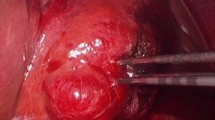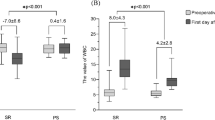Abstract
Background
Radiofrequency ablation (RFA), currently used extensively for liver tumors, also has been applied successfully to hepatic cavernous hemangioma (HCH) percutaneously. The aim of this study was to assess the feasibility, safety, and efficacy of laparoscopic RFA for patients with HCHs.
Methods
Between March 2001 and March 2004, 27 patients with symptomatic and rapid-growth lesions were treated by laparoscopic RFA using the RF-2000 generator system. The treatment-related complications were observed. All the patients were followed up with helical computed tomography scans and ultrasonography at regular intervals to assess the therapeutic efficacy of laparoscopic RFA.
Results
This study assessed 9 men and 18 women with a mean age of 41.6 ± 8.3 years. Three additional intrahepatic lesions missed preoperatively were found in three patients on intraoperative ultrasound. A total of 27 patients with 50 liver lesions were treated successfully with laparoscopic RFA. The mean maximum tumor diameter was 5.5 ± 2.0 cm. The mean length of time for RFA per lesion was 20.7 ± 11.9 min, and the mean blood loss was 134.4 ± 88.9 ml. Laparoscopic cholecystectomy was performed simultaneously for gallstones in 13 patients and for abutting of gallbladder from hemangioma in 2 patients. In addition, 3 patients also had a laparoscopic deroofing of simple hepatic cysts. Although postoperative low-grade fever and transient elevation of serum transaminase levels were observed in 13 patients, there were no complications related to laparoscopic RFA. During a median follow-up period of 21 months (range, 12–42 months), complete lesion necrosis was achieved for all the patients.
Conclusions
Laparoscopic RFA therapy is a safe, feasible, and effective treatment option for patients with symptomatic and rapid-growth HCHs located on the surface of the liver or adjacent to the gallbladder. Intraoperative ultrasonography is a useful adjunct for detecting additional liver lesions and offering more accurate targeting for RFA.

Similar content being viewed by others
References
Berber E, Rogers S, Siperstein A (2005) Predictors of survival after laparoscopic radiofrequency thermal ablation of hepatocellular cancer: a prospective study. Surg Endosc 19: 710–714
Biecker E, Fischer HP, Strunk H, Sauerbruch T (2003) Benign hepatic tumours. Z Gastroenterol 41: 191–200
Buscarini E, Savoia A, Brambilla G, Menozzi F, Reduzzi L, Strobel D, Hansler J, Buscarini L, Gaiti L, Zambelli A (2005) Radiofrequency thermal ablation of liver tumors. Eur Radiol 15: 884–894
Corigliano N, Mercantini P, Amodio PM, Balducci G, Caterino S, Ramacciato G, Ziparo V (2003) Hemoperitoneum from a spontaneous rupture of a giant hemangioma of the liver: report of a case. Surg Today 33: 459–463
Cui Y, Zhou LY, Dong MK, Wang P, Ji M, Li XO, Chen CW, Liu ZP, Xu YJ, Zhang HW (2003) Ultrasonography-guided percutaneous radiofrequency ablation for hepatic cavernous hemangioma. World J Gastroenterol 9: 2132–2134
Farges O, Daradkeh S, Bismuth H (1995) Cavernous hemangiomas of the liver: are there any indications for resection? World J Surg 19: 19–24
Gaspar L, Mascarenhas F, da Costa MS, Dias JS, Afonso JG, Silvestre ME (1993) Radiation therapy in the unresectable cavernous hemangioma of the liver. Radiother Oncol 29: 45–50
Giavroglou C, Economou H, Ioannidis I (2003) Arterial embolization of giant hepatic hemangiomas. Cardiovasc Intervent Radiol 26: 92–96
Hansen PD, Rogers S, Corless CL, Swanstrom LL, Siperstien AE (1999) Radiofrequency ablation lesions in a pig liver model. J Surg Res 87: 114–121
Huang XQ, Huang ZQ, Duan WD, Zhou NX, Feng YQ (2002) Severe biliary complications after hepatic artery embolization. World J Gastroenterol 8: 119–123
Ishak KG, Rabin L (1975) Benign tumors of the liver. Med Clin North Am 59: 995–1013
Jiao LR, Hansen PD, Havlik R, Mitry RR, Pignatelli M, Habib N (1999) Clinical short-term results of radiofrequency ablation in primary and secondary liver tumors. Am J Surg 177: 303–306
Lerner SM, Hiatt JR, Salamandra J, Chen PW, Farmer DG, Ghobrial RM, Busuttil RW (2004) Giant cavernous liver hemangiomas: effect of operative approach on outcome. Arch Surg 139: 818–821
Ochsner JL, Halpert B (1958) Cavernous hemangioma of the liver. Surgery 43: 577–582
Raut CP, Izzo F, Marra P, Ellis LM, Vauthey JN, Cremona F, Vallone P, Mastro A, Fornage BD, Curley SA (2005) Significant long-term survival after radiofrequency ablation of unresectable hepatocellular carcinoma in patients with cirrhosis. Ann Surg Oncol 12: 616–628
Shimoji K, Shiraishi R, Kuwatsuru A, Maehara T, Matsumoto T, Kurosaki Y (2004) Spontaneous subacute intratumoral hemorrhage of hepatic cavernous hemangioma. Abdom Imaging 29: 443–445
Srivastava DN, Gandhi D, Seith A, Pande GK, Sahni P (2001) Transcatheter arterial embolization in the treatment of symptomatic cavernous hemangiomas of the liver: a prospective study. Abdom Imaging 26: 510–514
Tateishi R, Shiina S, Teratani T, Obi S, Sato S, Koike Y, Fujishima T, Yoshida H, Kawabe T, Omata M (2005) Percutaneous radiofrequency ablation for hepatocellular carcinoma: an analysis of 1,000 cases. Cancer 103: 1201–1209
Tsai HP, Jeng LB, Lee WC, Chen MF (2003) Clinical experience of hepatic hemangioma undergoing hepatic resection. Dig Dis Sci 48: 916–920
Zagoria RJ, Roth TJ, Levine EA, Kavanagh PV (2004) Radiofrequency ablation of a symptomatic hepatic cavernous hemangioma. AJR Am J Roentgenol 182: 210–212
Author information
Authors and Affiliations
Corresponding author
Rights and permissions
About this article
Cite this article
Fan, RF., Chai, FL., He, GX. et al. Laparoscopic radiofrequency ablation of hepatic cavernous hemangioma. Surg Endosc 20, 281–285 (2006). https://doi.org/10.1007/s00464-005-0184-8
Received:
Accepted:
Published:
Issue Date:
DOI: https://doi.org/10.1007/s00464-005-0184-8




